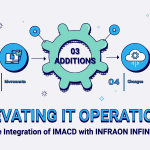The digital shift has particularly influenced the world of network management, where traditional monitoring is gradually giving way to AI operations (AIOps) solutions. It illustrates a clear shift towards automated and predictive IT operations management. While traditional systems have their place, particularly in smaller or less complex environments, AIOps represents the future of network monitoring, offering the ability to anticipate and prevent issues.
To understand the implications of this change, let’s compare traditional network monitoring systems with AIOps solutions.
Related blog: Top 7 Key Features Your Network Monitoring Software Should Have
All about traditional network monitoring
System administrators rely on traditional network monitoring systems to provide alerts for issues such as server downtime, network congestion, and hardware failures. These systems are rule-based and require thresholds to be set for triggering alerts. Once an issue is flagged, it is up to the network administrators to diagnose the problem and implement a solution.
The strength of traditional monitoring lies in its simplicity. For known issues and expected problems, it offers a clear approach. Network administrators can set up specific parameters and receive notifications when they are exceeded.
However, this simplicity also leads to its limitations. Traditional systems can only react to predefined conditions. They are not designed to handle the complexity of modern networks, which are characterized by a vast array of devices, configurations, and ever-changing traffic patterns.
Traditional monitoring systems may also generate a significant number of false positives or alert fatigue. The sheer volume of alerts can desensitize network administrators to warnings, potentially leading to oversight of critical issues. These systems lack predictive capabilities and are unable to adapt to new or unforeseen problems. As the complexity of networks grows, these systems require more and more manual configuration and maintenance, which can be time-consuming and prone to human errors.
Understanding AIOps-based network monitoring

AIOps solutions, as the name implies, leverage AI and ML to automate and improve network monitoring processes. They are designed to handle the complexity of modern IT environments, creating a holistic view of the network landscape and the ability to predict and prevent issues before they affect operations.
One of the main advantages of AIOps over traditional network monitoring is its ability to learn and adapt. By leveraging ML algorithms, AIOps platforms can assess huge data volumes in real-time to detect patterns that may indicate potential problems. So, they can predict issues before they occur, allowing for preemptive action to be taken, thus minimizing downtime and enhancing performance.
AIOps solutions can also process and analyze data from various sources, including metrics, logs, and events, to provide a full understanding of the network’s health. This integrated approach allows for more accurate detection of anomalies, reducing the number of false positives and enabling IT teams to focus on genuine threats and issues.
Another key benefit of AIOps platforms is that they can automate routine tasks and responses to common issues. It frees up IT staff to concentrate on more complex and strategic work. This automation goes beyond simple tasks to incorporate complex decision-making processes and determine the best course of action based on past events and current conditions.
Traditional network monitoring vs. AIOps-based network monitoring

When comparing traditional network monitoring with AIOps solutions, several critical differences emerge:
- Dealing with network complexity: Traditional systems struggle with the complexity of modern networks, while AIOps solutions thrive in it, using sophisticated algorithms to manage diverse and intricate network environments.
- Leveraging predictive capabilities: Traditional monitoring systems are inherently reactive, only alerting after a threshold is breached. AIOps, on the other hand, can predict issues before they impact the network, allowing for a more proactive approach to network management.
- Performing data analysis: AIOps can analyze massive quantities of data from multiple sources to identify issues, trends, and potential improvements. Traditional systems are limited to the data they are explicitly programmed to monitor.
- Monitoring automation: AIOps solutions can automate responses to a wide range of issues, reducing the need for human intervention and the potential for error. Traditional systems require manual configuration and are dependent on human decision-making.
- Monitoring scalability: AIOps platforms are scalable and capable of handling the growth in data volume and network complexity without a proportional increase in management resources. Traditional systems, however, become more cumbersome as the network grows.
- Integrating the solution: AIOps solutions are generally better equipped to integrate with other systems and technologies, offering a more unified approach to IT operations management. Traditional systems often operate in silos and may have difficulty integrating with new technologies.
4 challenges of future-proofing network monitoring workflows
Hence, it’s obvious that AIOPs-based solutions represent a more evolved approach to network monitoring compared to the traditional approach. However, it’s important to be conscious of the AIOPs-related challenges that one may face along the way. Let’s quickly look at a few of them:
- Data volume and quality: AIOps systems rely on huge data volumes to train ML models and provide actionable insights. This can be overwhelming since bad data quality can lead to inaccurate analyses and predictions.
- Integration difficulties: Many have legacy systems and a mix of different technologies that must be considered. Ensuring AIOps platforms can retrieve and interpret data from all relevant sources without disrupting current operations requires thorough planning and execution.
- Skillset expectations: Implementing AIOps solutions requires specialized skills in data science and artificial intelligence that existing IT staff may not possess.
- Costs: The setup and maintenance include the financial investment in the technology, training personnel, and potentially hiring new staff with the requisite expertise. For some organizations, the cost can be a barrier to entry.
Related blog: Network Monitoring System and All You Need to Know in 2023
Conclusion
Businesses embracing AIOps can expect to see measurable improvements in network uptime, performance, and security. They can also expect a reduction in the cost and effort associated with network management, as AIOps solutions automate many of the routine and repetitive tasks that consume IT resources. So, the transition from traditional network monitoring to AIOps is a strategic move to future-proof the whole technology ecosystem.























